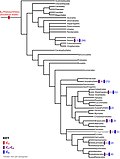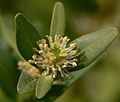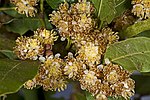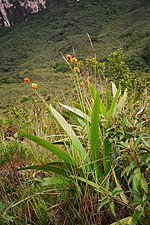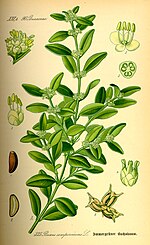Apodanthaceae and Gumillea, remained unplaced in APG III. Five taxa were unplaced among the angiosperms in APG III because Nicobariodendron and Petenaea...
30 KB (3,225 words) - 15:27, 3 July 2024
been unplaced in APG II. Nicobariodendron and Petenaea were newly added to the list. The latter was later placed into its own family Petenaeaceae in the...
47 KB (3,194 words) - 04:17, 8 April 2024
families unplaced as to order, although contained in supra-ordinal clades, in the APG system. APG II recognized 457 families, five fewer than the APG system...
7 KB (651 words) - 08:44, 20 October 2024
and Aextoxicaceae. However, APG II left the families unplaced as to order, assigning them to the clade core eudicots. The APG III system of 2009 formally...
2 KB (193 words) - 16:17, 25 April 2024
Angiosperm Phylogeny Group (category Scientific organizations established in 1998)
2016[update], three revisions have been published, in 2003 (APG II), in 2009 (APG III) and in 2016 (APG IV), each superseding the previous system. Thirteen...
33 KB (3,527 words) - 05:32, 8 April 2024
one family, Dilleniaceae. The APG III system of 2009, like the earlier APG II system of 2003, left the Dilleniaceae unplaced as to order, while noting that...
2 KB (170 words) - 03:02, 8 April 2024
Angiosperm Phylogeny Group (APG II) both families are unplaced to order, but nevertheless included in the Eurosids I. The APG III system of 2009, however...
5 KB (334 words) - 16:16, 7 September 2024
Angiosperm Phylogeny Group (APG) does not recognize the order, initially leaving the family Illiciaceae unplaced as to order. In its second higher level taxonomy...
3 KB (317 words) - 04:34, 8 April 2024
unplaced as to order, but was assigned to this same clade (although APG used the spelling "commelinoids"). The family contains almost 400 species in five...
4 KB (351 words) - 05:58, 8 April 2024
Trimeniaceae (section APG II)
the most basal lineages in the clade angiosperms. The APG system, of 1998, also recognized this family, but left it unplaced as to order, and regarded...
4 KB (440 words) - 02:50, 8 April 2024
which firmly recognised both families as separate. In both APG and APG II, the family Buxaceae is unplaced as to order and left among the basal lineages of...
4 KB (375 words) - 17:30, 26 October 2023
the clade monocots, unplaced as to order. The APG III system of 2009 and the APG IV system of 2016 placed the family Petrosaviaceae in the order Petrosaviales...
4 KB (400 words) - 05:13, 8 April 2024
Illiciaceae. The APG IV and APG III systems of taxonomy recognize this family and place it on the order Austrobaileyales. The APG II system, of 2003,...
11 KB (601 words) - 15:31, 22 August 2024
family Flacourtiaceae. The APG II system, of 2003 (unchanged from the APG system, of 1998), does recognize this family, unplaced as to order and merely assigned...
2 KB (221 words) - 04:05, 8 April 2024
absolutely proven. The APG II system, of 2003 (unchanged from the APG system of 1998), also recognizes this family, unplaced as to order, assigned to...
7 KB (669 words) - 22:03, 27 September 2024
Group (APG). It was published in 2016, seven years after its predecessor the APG III system was published in 2009, and 18 years after the first APG system...
40 KB (2,558 words) - 15:03, 19 September 2024
130 species in eight genera. In the APG II system it is one of eight families in the euasterids II clade (campanulids) that are unplaced as to order....
3 KB (204 words) - 04:20, 8 April 2024
tree in the broadleaf forests. It can reach 15 m tall. The APG system (1998) and the APG II system (2003) left the family Aextoxicaceae unplaced in the...
6 KB (522 words) - 07:24, 30 July 2024
Dasypogonaceae (category All Wikipedia articles written in Australian English)
conflicting models, and leave it in an order of its own, the Dasypogonales. The earlier APG III (2009), APG II (2003), and the 1998 APG system all accepted the...
7 KB (616 words) - 19:43, 5 September 2024
In the APG III system of 2009, the family is placed in its own order, Paracryphiales, in the campanulid clade of the asterids. In the earlier APG II system...
3 KB (233 words) - 05:38, 8 April 2024
Phylogeny Group classification for the orders and families of flowering plants: APG II". Botanical Journal of the Linnean Society. 141 (4): 399–436. doi:10.1046/j...
7 KB (590 words) - 20:52, 13 July 2024
flowering plants. The APG II system (2003) treats the family in the order Liliales, in the clade monocots. This is a slight change from the APG system, of 1998...
5 KB (456 words) - 02:46, 8 April 2024
Rafflesiaceae The APG II system regards Rafflesiaceae as an unplaced family of three genera. Also unplaced is the genus Mitrastema. However, APG II does have...
990 bytes (94 words) - 22:52, 9 October 2022
(including Cabombaceae) unplaced in any order. The APG III system did separate the Cabombaceae from the Nymphaeaceae and placed them in the order Nymphaeales...
17 KB (1,263 words) - 12:05, 5 March 2024
adopted. The APG II system does not recognize a group called "paleodicots" but assigns these early-diverging dicots to several orders and unplaced families:...
7 KB (654 words) - 18:28, 27 July 2024
represents a slight change from the APG system, 1998, which left the family unplaced as to order, but placed it in the same clade (although it used the...
3 KB (258 words) - 02:51, 8 April 2024
APG III system of 2009 and the APG II system of 2003. This represents a slight change from the APG system, of 1998, which left Hanguanaceae unplaced as...
6 KB (548 words) - 11:35, 2 October 2024
(asparagoid lilies) is an order of plants in modern classification systems such as the Angiosperm Phylogeny Group (APG) and the Angiosperm Phylogeny Web. The...
90 KB (8,459 words) - 21:10, 19 September 2024
Didymelaceae were given their own order. In the APG II system of 2003, the Buxaceae were a family unplaced as to order in the eudicots, optionally including the...
9 KB (970 words) - 17:22, 19 October 2024
Saxifragales (section APG)
Saxifragaceae alliance. In the clade Haloragaceae sensu lato (s.l.) + Crassulaceae the genera constituting Haloragaceae s.l. are all small, and APG II (2003) proposed...
77 KB (6,011 words) - 03:17, 3 October 2024

